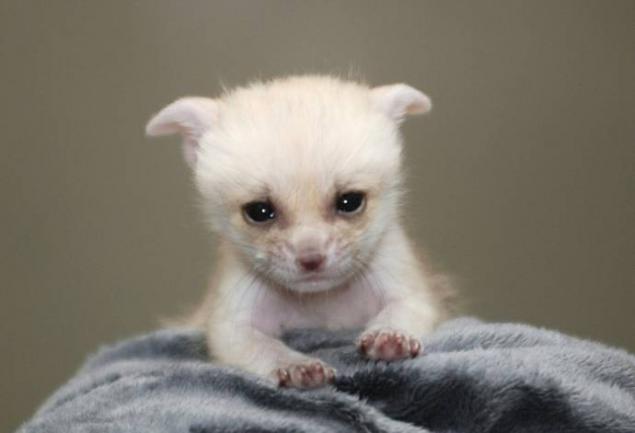595
Fenech zoo Seoul
These two tiny fox, Fenech recently were born in South Korean zoo Everland Zoo (Seoul).
Fenech-most amazing fox. His name Fenech received from Arab fanak, which means "fox." The scientific name Fenech «Vulpes zerda» (Vulpes means belonging to the genus foxes, zerda comes from the Greek word xeros, meaning "dry" and indicates the habitat Fenech - deserts of North Africa and the Arabian Peninsula).
6 photos via goodnewsanimal

However, not all scientists agree with belonging to the genus Fenech foxes, pointing to differences in the structure and behavior from other Fennec foxes. For example, Fenech all 32 pairs of chromosomes, whereas in the other species of foxes their number ranges between 35 and 39.
There are no Fenech musk glands, characteristic of foxes. Foxes are odichny lifestyle, while Fenech - a social animal. On the basis of these differences, some scientists isolated Fenech in a special race - «Fennecus».

The size Fenech less than a domestic cat. Height 18-22 cm, length - 30-40 cm, tail - 30 cm, weighs up to 1, 5 kg. Ears Fenech - the largest among the predators in relation to the size of the head; they reach 15 cm in length. Such big ears Fenech needed not only for the reason that he has the slightest rustle in the sand to learn about the movement of their main prey - insects and small vertebrates.

Ears Fenech - an excellent source of thermoregulation: the blood vessels that are in ushih and is close to the skin, allow Fenech rid the body of excess heat, which is vital in a hot desert climate.

Another means of adaptation to desert conditions Fenech are covered with hair foot that allows Fenech easily and quietly move on the hot sand. Color wool Fenech most adapted to cover up on the background of the desert sands: Fenech top fur is reddish or yellow, white bottom.
Young Fenech almost white. Fenech We, like other wild foxes, no sweat glands. Fenech can go without water for long periods, receiving fluid from foods. Kidney Fenech adapted to limit water loss.

Parents

Source:
Fenech-most amazing fox. His name Fenech received from Arab fanak, which means "fox." The scientific name Fenech «Vulpes zerda» (Vulpes means belonging to the genus foxes, zerda comes from the Greek word xeros, meaning "dry" and indicates the habitat Fenech - deserts of North Africa and the Arabian Peninsula).
6 photos via goodnewsanimal

However, not all scientists agree with belonging to the genus Fenech foxes, pointing to differences in the structure and behavior from other Fennec foxes. For example, Fenech all 32 pairs of chromosomes, whereas in the other species of foxes their number ranges between 35 and 39.
There are no Fenech musk glands, characteristic of foxes. Foxes are odichny lifestyle, while Fenech - a social animal. On the basis of these differences, some scientists isolated Fenech in a special race - «Fennecus».

The size Fenech less than a domestic cat. Height 18-22 cm, length - 30-40 cm, tail - 30 cm, weighs up to 1, 5 kg. Ears Fenech - the largest among the predators in relation to the size of the head; they reach 15 cm in length. Such big ears Fenech needed not only for the reason that he has the slightest rustle in the sand to learn about the movement of their main prey - insects and small vertebrates.

Ears Fenech - an excellent source of thermoregulation: the blood vessels that are in ushih and is close to the skin, allow Fenech rid the body of excess heat, which is vital in a hot desert climate.

Another means of adaptation to desert conditions Fenech are covered with hair foot that allows Fenech easily and quietly move on the hot sand. Color wool Fenech most adapted to cover up on the background of the desert sands: Fenech top fur is reddish or yellow, white bottom.
Young Fenech almost white. Fenech We, like other wild foxes, no sweat glands. Fenech can go without water for long periods, receiving fluid from foods. Kidney Fenech adapted to limit water loss.

Parents

Source:























